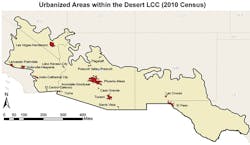Water Harvesting, Green Infrastructure, and Low Impact Development
Active water harvesting strategies capture water that runs off impervious surfaces and stores it in tanks or other containers for later beneficial use. Passive water harvesting strategies shape the landscape to infiltrate water into the soil for immediate benefit. Both methods capture water as close to its source as possible.
Passive practices can take place at multiple scales ranging from small residential rain gardens to microbasins in street rights of way to regional stormwater management facilities. Larger-scale applications are often termed green infrastructure (GI) or low impact development (LID), both of which denote using or mimicking natural hydrologic process and features to manage stormwater and provide environmental and community benefits. The terms GI and LID are being used more and more interchangeably to discuss approaches to managing urban stormwater runoff as a resource rather than a waste product.
Active water harvesting strategies capture water that runs off impervious surfaces and stores it in tanks or other containers for later beneficial use. Passive water harvesting strategies shape the landscape to infiltrate water into the soil for immediate benefit. Both methods capture water as close to its source as possible. Passive practices can take place at multiple scales ranging from small residential rain gardens to microbasins in street rights of way to regional stormwater management facilities. Larger-scale applications are often termed green infrastructure (GI) or low impact development (LID), both of which denote using or mimicking natural hydrologic process and features to manage stormwater and provide environmental and community benefits. The terms GI and LID are being used more and more interchangeably to discuss approaches to managing urban stormwater runoff as a resource rather than a waste product. [text_ad] These water harvesting approaches have several benefits. By capturing rainwater in tanks or cisterns or letting it infiltrate into the ground rather than running down driveways, roads, and other impervious surfaces, water harvesting helps mitigate flooding issues. Rainwater stored in the soil or in tanks provides an alternative to using potable water for non-potable uses, in particular watering vegetation. In arid regions of the Southwest, approximately 95% of the water that falls as rain evaporates before providing any water resource benefits. Tanks store water that would otherwise evaporate. Storing harvested water in tanks can reduce peak demand and associated needs for expanded water supply and distribution infrastructure. Vegetation supported by harvested water helps keep the urban environment green and cool. A velvet mesquite tree in Tucson, with a 20-inch-diameter trunk, can intercept almost 2,000 gallons of stormwater annually, infiltrating the runoff and using the stored water over time, reducing the need for irrigation. When used to increase urban canopy and to support strategically placed trees, water harvesting can help mitigate the urban heat island effect and reduce energy consumption through shade, evapotranspiration, and passive cooling of buildings and cars. In addition, while creating these sustainable benefits, water harvesting techniques effectively direct, infiltrate, and clean stormwater runoff. As a result, EPA has made clear that it supports and encourages the use of green infrastructure as a component of municipal separate storm sewer system (MS4s) plans. Research assessing the costs and benefits of water harvesting is only beginning to permit comparisons with other, more traditional methods, and much research remains to be done, especially in arid and semi-arid regions. However, evidence suggests that installing and maintaining these green stormwater techniques is price-competitive, or even less costly, than traditional gray infrastructure. Benefits tend to outweigh costs when viewed with a triple-bottom-line (economic, social, and environmental) analysis, especially when urban cooling is one of the project’s objectives. Secondary economic benefits of water harvesting include spending on birding and other watchable wildlife activities, increased value of properties with large trees, willingness to pay higher prices in shaded shopping areas, and improved longevity of shaded pavement.These water harvesting approaches have several benefits. By capturing rainwater in tanks or cisterns or letting it infiltrate into the ground rather than running down driveways, roads, and other impervious surfaces, water harvesting helps mitigate flooding issues. Rainwater stored in the soil or in tanks provides an alternative to using potable water for non-potable uses, in particular watering vegetation.
In arid regions of the Southwest, approximately 95% of the water that falls as rain evaporates before providing any water resource benefits. Tanks store water that would otherwise evaporate. Storing harvested water in tanks can reduce peak demand and associated needs for expanded water supply and distribution infrastructure. Vegetation supported by harvested water helps keep the urban environment green and cool. A velvet mesquite tree in Tucson, with a 20-inch-diameter trunk, can intercept almost 2,000 gallons of stormwater annually, infiltrating the runoff and using the stored water over time, reducing the need for irrigation.
When used to increase urban canopy and to support strategically placed trees, water harvesting can help mitigate the urban heat island effect and reduce energy consumption through shade, evapotranspiration, and passive cooling of buildings and cars. In addition, while creating these sustainable benefits, water harvesting techniques effectively direct, infiltrate, and clean stormwater runoff. As a result, EPA has made clear that it supports and encourages the use of green infrastructure as a component of municipal separate storm sewer system (MS4s) plans.
Research assessing the costs and benefits of water harvesting is only beginning to permit comparisons with other, more traditional methods, and much research remains to be done, especially in arid and semi-arid regions. However, evidence suggests that installing and maintaining these green stormwater techniques is price-competitive, or even less costly, than traditional gray infrastructure. Benefits tend to outweigh costs when viewed with a triple-bottom-line (economic, social, and environmental) analysis, especially when urban cooling is one of the project’s objectives.
Secondary economic benefits of water harvesting include spending on birding and other watchable wildlife activities, increased value of properties with large trees, willingness to pay higher prices in shaded shopping areas, and improved longevity of shaded pavement.
